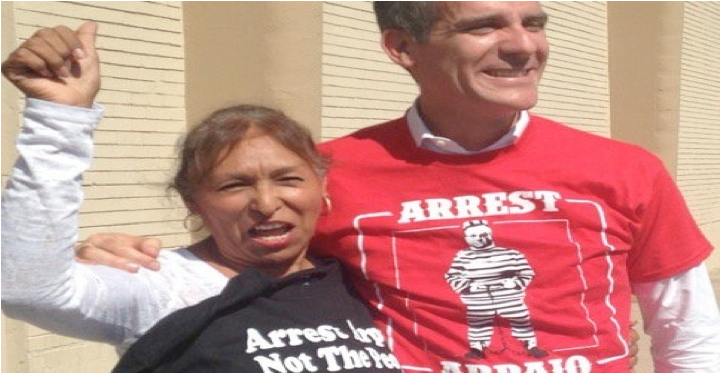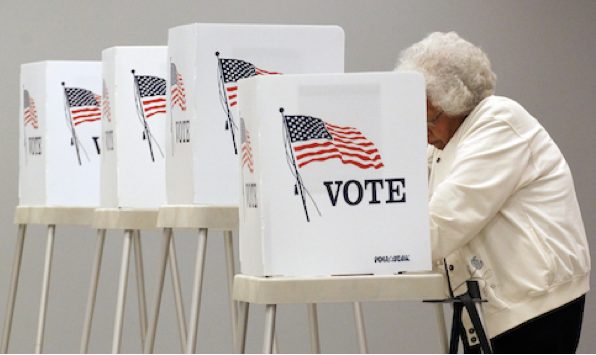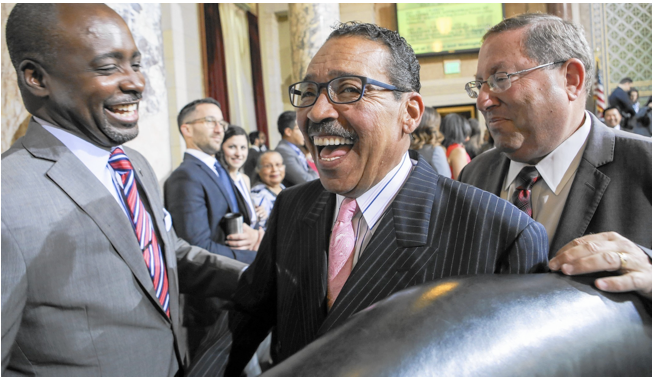VOX POP--“Since I’ve been displaced, I’ve seen more people who weren’t here before. Where my house was before, now it’s a fancy condominium.” Caridad Vasquez is talking about the changes that have come upon her neighborhood in the years since Metro – Los Angeles’ transportation system – expanded its subway and light-rail services, and helped turn this working-class, traditionally Latino neighborhood into a desirable new destination for young professionals. She is a long-time street vendor and local resident of the Boyle Heights district of Los Angeles. Today, sitting in an office of the East LA Community Corporation, Vasquez is wearing short turquoise flannel pants, a “Legalize Street Vending” T-shirt and sneakers with pink laces, loosely tied and no socks.
Vasquez is a supporter of Build Better LA (BBLA), a ballot initiative (officially, Measure JJJ) crafted by a consortium of transportation advocates and neighborhood groups – including the Alliance for Community Transit-Los Angeles (ACT-LA), the land trust organization TRUST South LA, the tenants advocacy group Strategic Actions for a Just Economy (SAJE) and the Koreatown Immigrant Workers Alliance — along with the LA County Federation of Labor and another union group, the Building Trades Council. The proposal emerged from a number of policy discussions from 2015 onwards, and was placed on the November ballot to take the steam out of a competing measure – now pushed back to March, 2017 – that would impose a two-year development moratorium in many areas, protecting old housing stock but doing nothing to alleviate the growing lack of access to affordable housing.
Since 2008 America’s second-largest city has embarked on a $40 billion, long-overdue drive to provide itself with a comprehensive public transit system. That system is made up of Metro’s subway, light rail and bus lines, and at long last it is becoming possible and easy to use mass transit to journey from the Pacific to the far eastern suburbs, and from Pasadena in the north to Long Beach far in the south. Yet one of the side effects of this transformation has been displacement of older, poor communities – ironically, the very demographic that most uses public transport — along these rapidly gentrifying corridors.
 To attack the problem, BBLA presents two goals. The first is to provide a series of carrot-and-stick incentives to developers along transit corridors to include a large number of affordable housing units in their new developments. This would essentially refuse to allow the general plan amendments and zoning changes that are needed for almost any new large development, along transit routes, unless developers either build a percentage of units to be affordable, or pay into the city’s affordable housing trust fund so as to allow units to be built elsewhere.
To attack the problem, BBLA presents two goals. The first is to provide a series of carrot-and-stick incentives to developers along transit corridors to include a large number of affordable housing units in their new developments. This would essentially refuse to allow the general plan amendments and zoning changes that are needed for almost any new large development, along transit routes, unless developers either build a percentage of units to be affordable, or pay into the city’s affordable housing trust fund so as to allow units to be built elsewhere.
It is a recognition of the reality that, despite LA moving toward a higher minimum wage, for many workers the cost of housing remains entirely prohibitive. According to attorney Doug Smith, of Public Counsel, a pro bono law firm that works with affordable housing advocates citywide, a higher percentage of L.A. residents are “rent burdened” – meaning that they are paying over 30 percent of their income on rent or on a mortgage — than any other large city residents in the United States.
“The fight in 2015 was to raise and enforce the wage in the city of L.A.,” says Rusty Hicks, executive secretary-treasurer of the County Federation of Labor. “But it became clear you also had to address issues connected to housing and housing affordability.”
BBLA’s second part, which is being pushed by Hicks and other allies in L.A.’s powerful unions, is a series of labor standards to ensure that workers on these projects are paid decently, come out of union apprenticeship programs, that at least 30 percent are local hires and that 10 percent have to be from disadvantaged communities – that are made up of nine criteria, including foster care youth, single mothers, veterans, the homeless and ex-prisoners.
“We’re making clear what the rules of the road are with regards to development,” Hicks says.
Supporters of BBLA calculate that had these rules been in place over the last few years during the city’s building boom, more than 5,500 affordable units would have been built along transit corridors between 2013 and 2015, and more than 11,000 good-paying construction jobs would have been generated. While these numbers are guesstimates, they are based on an analysis of the development projects that did go through during this time and an understanding of how different those projects would have been had they incorporated BBLA levels of affordable housing into their designs.
Despite some opposition from the Chamber of Commerce, from some tenants’ groups and from the Coalition to Preserve LA , the group behind the competing initiative, with less than a month to go before the election BBLA continues to poll strongly – internal numbers from the campaign suggest support in the 70 percent region, and most proponents are assuming that come next year it will be a core part of L.A.’s affordable housing strategy. In fact, so sure are developers that it will pass that at least some have apparently sought to push through city planning commission requests to approve development projects before November, as a way to get around the anticipated new affordable housing requirements.
City planning officials didn’t respond to repeated requests to comment on this, nor did they address advocates’ concerns that the commission will be holding more frequent, and longer, hearings between now and November in order to process more projects; but Kevin Keller, deputy director of city planning, acknowledges that it’s at least possible that the developers of some projects already close to the approval process finishing line may be trying to sneak in under the wire. “Regulatory changes often do create a little blip, a spike in filing,” he says.
Jill Stewart, campaign director of the Coalition to Preserve LA, argues that the developers actually don’t have much to lose should BBLA pass. “It sets up a series of backroom meetings between individual council members and the developer,” she argues, in explaining her group’s opposition. “All of whom give the council members campaign cash, and wine and dine them.” It is, she believes, a bad deal for the city, one that would create what she calls “backroom deals on steroids” as a central part of the city’s development strategy. She also argues that the way the measure is worded it would, in fact, give developers plenty of leeway to argue that including affordable housing would unfairly limit their profits, and thus to wiggle out of their promises to provide such units on site. “It’s going to be a disaster. Over-building without affordable housing.”
Amongst housing activists in the city, however, Stewart’s stance is in the minority. Many groups argue strongly that the initiative is a far better way of bulking up the affordable housing stock than other plans that have been put forward in recent years.
Assuming Measure JJJ passes, and assuming that, despite the concerns of Stewart and others, its changes will indeed protect and expand affordable housing, it won’t come too soon for Caridad Vasquez.
“For me, Boyle Heights is a very humble community,” Vasquez says. She feels, fairly or not, that “Metro didn’t benefit this community.” She talks of soaring rents, of older buildings demolished and replaced by luxury apartments, of families who have had to move out, and of mom and pop businesses replaced by chain stores. “Right before the Metro came, there were a lot of rumors it would bring change, and a lot of us would be displaced. And the rumors came true.”
What has happened in Boyle Heights is occurring in Koreatown, in South Los Angeles, in Chinatown (along the route of a soon-to-be-expanded Gold Line Metro Rail) and in old communities nestled around the huge University of Southern California campus.
Transit advocates such as Laura Raymond, of the Alliance for Community Transit, estimate that 60 percent of new housing development in L.A. is now occurring near new Metro stations; and the great majority of this housing is unaffordable to low-income Angelenos.
In addition to promoting BBLA, city officials, affordable housing experts, labor unions, transportation advocates and neighborhood groups have been pushing rule changes around development to encourage an expansion of the city’s woefully inadequate affordable housing stock. Mayor Eric Garcetti recently announced a goal for the building of 100,000 more housing units in the city by 2021, of which at least 15,000 will be specifically earmarked as affordable to low-income renters. Los Angeles, explains the city planning department’s Keller, is using an array of zoning tools to incentivize mixed-income developments, “to really produce housing along our commercial corridors.” It’s a good start, but not nearly enough to meet the cascading need as both real estate values and rental prices continue to soar in the City of Dreams.
This is, after all, a crisis decades in the making. Since the Reagan years, the federal government has failed to build up a stock of new public housing. California’s redevelopment agencies, which were once major facilitators of public housing, no longer exist. And while in LA many existing rental units are rent-controlled, recent law changes and court rulings mean that new developments are not subject to such controls. Moreover, the statewide Costa-Hawkins law, passed in 1995, has prevented cities from limiting rents on newly vacated apartments, which has diluted the rent-controlled housing stock. And a legal ruling in a lawsuit filed against the city by one of the region’s leading developers, Geoffrey Palmer, also prohibits LA from mandating affordable housing set-asides in new developments.
As a result, the city’s affordable housing stock is crumbling in quality and, as older buildings are replaced by newer developments, also declining in quantity. All of this feeds into an affordable housing crisis of huge proportions, one that helps explain the city’s homelessness epidemic, the overcrowding seen in apartment buildings in poorer neighborhoods and the increased displacement of working-class residents to the far reaches of the megalopolis.
Alan Greenlee, executive director of the Southern California Association of Non-Profit Housing, quotes data produced by his members estimating the city has a shortfall of more than half a million affordable housing units. “Dang man,” he says in the organization’s fourth-floor offices in a Koreatown tower block, while explaining why he threw his organization’s support behind BBLA, despite some members’ concerns about the high costs of the initiative’s labor provisions. “That’s an emergency,” Greenlee says. “We’re at a break-the-glass-pull-the-fire-alarm kind of moment.”
Nati R’s (her last name has been withheld at her request) apartment, in South Los Angeles’ Trinity Park neighborhood, is a case study of the risks in play there for long-established residents.
For years, her building has been allowed to deteriorate, with disintegrating, damp walls, floors that periodically collapse in places, an elevator that frequently doesn’t work. For years, too, the streets surrounding the apartment block were home to gangs, to shootings, to what residents euphemistically term “activity.”
The trade-off for these abysmal conditions has been cheap rent for low-income residents who don’t have other options in the city. Nati shares the apartment, whose walls are covered with Mexican artwork, with her husband, her daughter and, at times, her son and his growing family.
Over the last few years, however, Nati and her neighbors have helped reclaim their streets, prettifying the local parks while working to tamp down the violence that for too long plagued their community.
Now, however, she fears that all of that hard work will, ultimately, benefit not her but newer, more affluent residents. Recently her building was, according to SAJE staffers, sold for $2.4 million, and apartments that used to rent for $850 are now going for $1,200. “The biggest fear,” she says in Spanish at her kitchen table, “is to be displaced, to be pushed out, to be left on the edges of the city where we don’t have our community. We make minimum wage. We can’t pay $1,000 rent.”
South of Downtown, at the Tuesday afternoon tenants’ clinic, run out of the SAJE offices that are adorned with banners from an array of tenants’ fights over the years, a middle-aged woman named Sonya tells the volunteer attorney about the eviction notice she received in early summer.
Sonya, who requested that only her first name be used, lives just two blocks west of the USC campus and the city’s Natural History Museum, in a one-bedroom, $850-per-month, rent-controlled apartment complex where long-time residents now find themselves competing with university faculty — who come onto the market with tens of thousands of dollars in housing subsidies given them by the university. Ostensibly, the reason the company that owns Sonya’s building wants her out is so that it can renovate the unit – even though, under the city’s Housing and Community Investment Department rules, that is not a legitimate reason to evict a tenant from a rent-controlled building. The SAJE people suspect that, in reality, the owners want her gone so that they can bring in a tenant who would pay a far higher rent.
The SAJE team and the attorney advise her not to vacate, that the eviction isn’t legal. Sonya, wearing glasses, her hair dyed brown, seems to breathe easier. She knows that at her stage in life, beginning anew isn’t something to take lightly. But then the SAJE team gently brings her down to earth. Be prepared, they warn her — the landlord will almost certainly try again, looking for another excuse to kick her out, looking for some other way to take advantage of the red-hot real estate markets created by the city’s investments in its transit corridors.
“The value of the investment in public transit is diminished if you’re driving transit users away,” argues Sandra McNeill of TRUST South LA, speaking in the group’s cluttered offices in a converted storefront church a couple miles from Downtown. “There’s a tremendous rationale to having a comprehensive policy in place.” With BBLA, she says, there’s finally a chance of stabilizing neighborhoods too long roiled by unconstrained real estate speculation. “We’re just doing what I think the city should have done a long time ago.”
(Sasha Abramsky writes for Capital and Main … where this column was first posted.) All photos by Pandora Young
-cw




 And they were. On January 10, 2014, the men who murdered Matthew
And they were. On January 10, 2014, the men who murdered Matthew  Everyone knows how wrong I think Los Angeles City Charter Amendment Measure RRR:
Everyone knows how wrong I think Los Angeles City Charter Amendment Measure RRR: 





 Ellis, at age 43, is also a leader in state Democratic circles. She is recording secretary of the state party's African American Caucus and a member of the party's Finance Committee.
Ellis, at age 43, is also a leader in state Democratic circles. She is recording secretary of the state party's African American Caucus and a member of the party's Finance Committee. 
 To attack the problem, BBLA presents two goals. The first is to provide a series of carrot-and-stick incentives to developers along transit corridors to include a large number of affordable housing units in their new developments. This would essentially refuse to allow the general plan amendments and zoning changes that are needed for almost any new large development, along transit routes, unless developers either build a percentage of units to be affordable, or pay into the city’s affordable housing trust fund so as to allow units to be built elsewhere.
To attack the problem, BBLA presents two goals. The first is to provide a series of carrot-and-stick incentives to developers along transit corridors to include a large number of affordable housing units in their new developments. This would essentially refuse to allow the general plan amendments and zoning changes that are needed for almost any new large development, along transit routes, unless developers either build a percentage of units to be affordable, or pay into the city’s affordable housing trust fund so as to allow units to be built elsewhere.


 Well, maybe so. But Weinstein experienced the same fury and frustration that thousands of powerless Angelenos feel when they wake up one morning to see a tower under construction next door on land that wasn’t supposed to allow such structures. If they investigate, they likely discover that – surprise! – a deal was cut in City Hall.
Well, maybe so. But Weinstein experienced the same fury and frustration that thousands of powerless Angelenos feel when they wake up one morning to see a tower under construction next door on land that wasn’t supposed to allow such structures. If they investigate, they likely discover that – surprise! – a deal was cut in City Hall.


 Art Leahy: “When I came to Metrolink, not only did we have a board that was ready to break up, but within the management staff, we had a culture of avoidance, deferral, and concealment or denial.
Art Leahy: “When I came to Metrolink, not only did we have a board that was ready to break up, but within the management staff, we had a culture of avoidance, deferral, and concealment or denial. 















